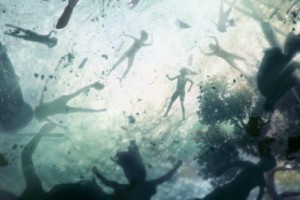By: debbie lynn elias
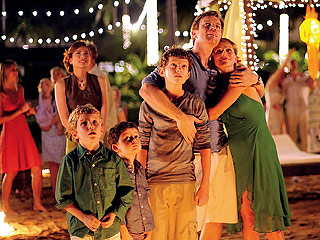
Who doesn’t remember where they were or what they were doing on December 26, 2004, when a world-shattering tsunami arose in the Indian Ocean, decimating the entire region as it pummeled onto the shores of Thailand and elsewhere with such force so as to not only destroy land and property, but eradicate shipping lanes and reshape the underlying seabed. Slowly we saw video emerge of the devastation, at first from the cell phones and cameras of tourists celebrating the Christmas holidays in the lush tropical setting of Thailand. Slowly, we heard stories emerging describing the wall of water and debris, the fear, the panic, the search for loved ones in the aftermath. At the end of the day, the loss of life was unfathomable; the devastation too horrible to imagine. With a script by Sergio Sanchez based on the true experiences of the Belon family, director Juan Antonio Bayona now floods us with emotion and horror, and joy, of reality with THE IMPOSSIBLE.
Maria and Henry were vacationing with their three young boys, Lucas, Simon and Thomas, in Kha Lok, Thailand for Christmas. With a stunning ocean view from their suite, the vacation was idyllic. Christmas morning was filled with all the wonder and surprises that the holiday should hold for a family. But on December 26, all that wonder and childlike innocence disappeared when a massive tidal wave swept across the region, destroying everything in its wake. One minute, Maria is relaxing in a poolside chair, waving to her husband and sons who are in one of the hotel pools; the next, a wall of dirty brown, rushing water was slamming into them and everything in its path like a ton of concrete being poured over them.
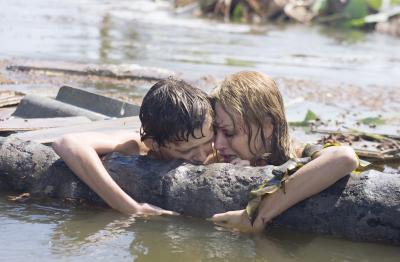
With raging fury, we are swept under the waves with Maria. Far below the surface, her lungs ache for oxygen as her body is tossed about like a limp rag doll, being hammered and tortured by trees, cars, electrical poles, everything that also fallen victim to the tsunami. Finally giving in to what she believes is her ultimate fate, she stops struggling, but then is suddenly thrust to the surface, caught in a torrent of rushing water. Calling out for her family, suddenly she sees her eldest son Lucas. Like a mother lion bent on protecting her cub, adrenalin and a mother’s love kicks into high gear and she struggles to reunite herself with him and save him from what she is certain is death. Fighting currents, waves and structural objects in their paths, the two reach each other. But Maria has little fight left in her. She is badly injured, bleeding profusely. But a miracle happens, Lucas starts to take charge. He is determined for them to survive and before Maria’s eyes, he becomes a little man. Pushing her when she can go no further, helping save a toddler stranded from the water, salvaging a can of Coke for some sort of liquid replenishment for the body and then finding help for them, Lucas assumes the responsibilities of head of the household as Henry, Simon and Thomas are nowhere in sight.
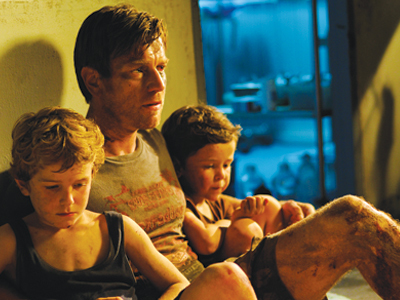
With Maria taken to a hospital, we see the chaos and turmoil the disaster has caused. Displaced families, the dead, the injured, not enough doctors or supplies. Death and destruction are everywhere. Maria, a doctor, knows how bad her own condition is and asks Lucas pointed questions about her body. Chunks of her thigh were ripped away during the tsunami while other parts of her body were impaled with objects churning in the waters. Lucas lies about her true condition, wanting to keep his mother fighting, as massive septic infection has set in throughout her body and available medical care is pushed to the brink with a shortage of supplies, medicine and doctors. And while Maria and Lucas pray for their survival, we are then taken to another part of the region to see Henry walking barefoot among the dirt and debris frantically searching for Maria and Lucas. Miraculously, Simon and Thomas are also alive. Determined to not give up on Maria and Lucas, Henry puts his two youngest on a truck of refugees bound for the safety of higher ground while he stays to search.
And so the frantic journey begins for a hoped reunification of this family with neither half knowing if the other is still alive.
As Maria, Naomi Watts stuns. Battered and bloodied, in the aftermath of the tsunami she is essentially immobile in a hospital bed but through her eyes and feeble manipulation and movement of her lips and fingers, she makes you feel as if death is lingering. Powerful. Heart wrenching. And yes, you will find yourself with a lump in your throat, tears in your eyes and silently praying to the screen. Ewan McGregor captivates with his eyes and speech cadence, eliciting a frantic fear that is palpable. McGregor makes you live with him each bloody barefoot step he takes in Henry’s search for Maria and Lucas.
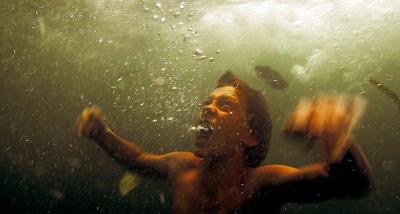
But it is Tom Holland who catapults to unanticipated and unseen emotional heights as the young Lucas that commands this film with the force of the tsunami. Holland IS the reason to see this film. A tour de force performance, he captures the emotional gravitas of the situation, making you want to reach out, grab him and hold him close. Particularly touching are Holland’s scenes when trying to help reunite people in the hospital as he runs from floor to floor, wing to wing, taking names and searching. There is nothing scripted about the emotion of Holland.
Written by Sergio Sanchez based on the actual story of the Belon family, Maria Belon has been involved in the project every step of the way, providing insightful guidance to the story, the characters and the depiction of the events, all of which Sanchez has embraced and structured into this powerful script. In speaking with both Sanchez and Belon, it was heart-stopping to learn that what we see on screen is “tame and toned down” in comparison to the horrors that the Belons and others endured.
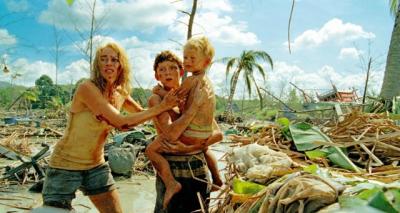
Director Bayona and cinematographer Oscar Faura hold us captive for the first half of the film, and especially the first 15-20 minutes, as they meticulously recreate the onslaught of the tidal wave, assailing the senses with terror, horror and shock. And this is not a CGI tidal wave, although there are some CGI enhancements. Utilizing the second largest water tank in the world and 35,000 gallons of water plus multiple underwater cameras and cranes, the wave, torrents and underwater sequences are actually lensed with Naomi Watts and Tom Holland strapped into spinning chairs underwater that toss them amidst the waves and debris. The fear on their faces, particularly Watts, is real and unyielding, hammering the emotional impact of the situation as fiercely as the tsunami. Shooting at the actual hotel where the Belon family stayed and at one of the area hospitals, in cathartic fashion, survivors and residents of the area participated in the filming of THE IMPOSSIBLE.
Dramatic and unwavering, THE IMPOSSIBLE will make you believe that anything IS possible.
Directed by Juan Antonio Bayona
Written by Sergio Sanchez based on the true story of Maria Belon
Cast: Naomi Watts, Ewan McGregor, Tom Holland, Samuel Joslin, Oaklee Pendergast, Geraldine Chaplin
